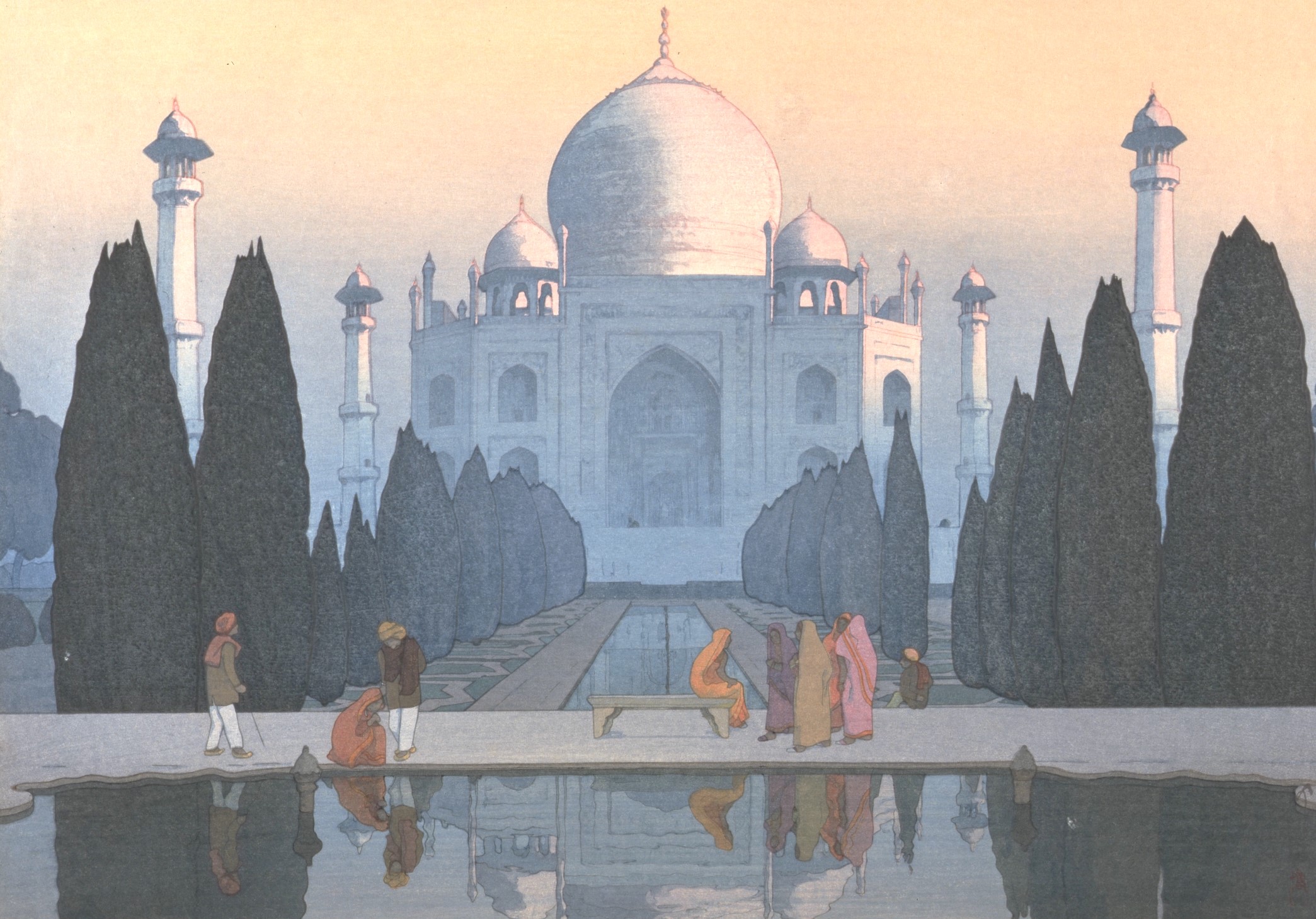Art Above the Seacoast of Atami
Hiroshi Yoshida "Changgyong Palace" (1937), Woodblock, Paper, MOA Museum of Art
For those who have not discovered another side of Atami apart from its breathtaking bright blue sea, the MOA Museum of Art is a worthwhile visit. Sitting on a scenic hill at 270 meters above sea level, the museum was redesigned by artist Hiroshi Sugimoto and architect Tomoyuki Sakakida of the firm Shinsoken. The Indian sandstone facade stretches across the rolling hill, blending beautifully with the surrounding trees. From here, a spectacular panoramic view of the ocean emerges. An underground passageway of escalators 25-to-35 meters long canopied by a colorful kaleidoscopic installation mesmerizes. Upon reaching the underground hall on Art Street, one is greeted by a mosaic ceiling of moving images in sea colors incorporating ten varieties of marble from Italy, Portugal, India, Iran, Cuba, and Greece. The long interior prelude to the main exhibition hall is art and design in itself, delivering utter excitement.

Running until January 25th, Travel Journals in Woodblock Prints: Yoshida Hiroshi and Kawase Hasui celebrates wonderful woodcut masterpieces by two highly acclaimed woodblock print artists. About 80 prints have been selected for their depictions of captivating sceneries across Japan and the world.
Hiroshi Yoshida (1876‒1950) was born to a samurai family from Fukuoka. He moved to Tokyo when he was 18 to study art, then five years later decided to travel to North America with his watercolor pictures. He succeeded in selling some of his works at the Detroit Institute of Arts and other galleries, enough to save money to travel to Europe. His journeys abroad influenced his art extensively and sharpened his drawing skills, eventually making him a leading figure in the watercolor, oil painting, and woodcut genres in the early 20th century. For this reason, he was largely recognized for painting foreign subjects in a Japanese woodblock style.

Yoshida was also an avid outdoorsman and hiker. He took full advantage of this passion to paint the magnificent national mountain treasures of America and Europe, especially during his travels there in 1923. Among Yoshida’s highlighted works is Mount Rainier (1925). Southeast of Seattle, Mount Rainier is the highest mountain in the state of Washington. Yoshida’s dramatic rendering of the mountain scenery uses earth colors scattered around a quiet pond in blue and grey tones that reflect towering forest trees. One also notices the use of bokashi (color gradation), which creates contrast between the white snowy parts of the mountain and the scattered red leaves on the ground.

From November 1930 to February 1931, Yoshida made a four-month trip to India. He visited various sites and national parks, painting endlessly before moving on to his next destination. He remarked that in India, he was “struck by the intricacy of the architecture, sculpture, craftwork, paintings, and natural environment.” The Taj Mahal in the Morning Mist (1932) was part of his travel series. The color gradation and blurry effect is, again, evident on the ghostly appearance of the mausoleum, while tall, green trees on both sides steal the limelight of the picture.
Hasui Kawase (1883‒1957) came from a trading family in Tokyo. He began learning painting at age 14, but was obliged to pause his studies to help his family business. It was only after he turned 25 when his brother-in-law stepped in to manage the trade that he resumed painting and taking sketching lessons from Saburōsuke Okada. Kawase produced woodblock landscape prints for the rest of his life, and like Yoshida, traveled widely across Japan to absorb inspiration from the local culture and striking beauty of nature, which resulted in over 600 works. His drawing style is marked by atmospheric effects and natural lighting, shade, and texture.

After the colossal Kanto earthquake of 1923, Kawase lost all of his sketches. He set out on a 102-day sketching trip a month after the disaster, producing the sketches that wouldform his Travel Series Part III. Included in this series is the notable work In the Snow, Nakayama-Shichiri Road, Hida (1924). Nakayama-Shichiri is famous for its valley and gorge sceneries along the Hida River. Kawase brilliantly captures the snow-capped Hida mountains, trees, house roofs, and ground, and accentuates the blue river and glittering windows of the village homes.

Kintai Bridge, Suo (1924) is an example of Kawase’s manipulation of colors in subdued tones. Kintai Bridge is in Yamaguchi Prefecture and spans the Nishiki River. Its stonework and wood construction details are intricate. Kawase's depiction shows a merchant on the bridge dressed in deep blue while carrying a yoke on his shoulders. He is immersed in the blue and green hues of the river, mountains, trees, and sky. On the river bank, a mother in white washes clothes while her daughter in red sits patiently—a scene providing both local feeling and artistic accent.
Another of Kawase’s bewitching prints is Zojo Temple, Shiba (1925). It portrays a realistic winter scene in which snow blows evenly across a stark red temple, as a woman with a huge umbrella struggles against ghastly winds. A snow-covered pine tree in the foreground adds a further touch of ingenuity to the picture.

After enjoying the exhibition, visitors can stroll around the museum garden to admire the reconstructed residence of the artist Korin Ogata. Other sights include the traditional Shotei teahouse, the modern Ippaku-an teahouse, charming pagodas, and historical gates.
Alma Reyes
Alma Reyes



